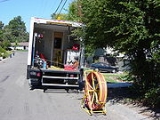
Pipeline video inspection
Encyclopedia
Pipeline video inspection is a form of telepresence
used to visually inspect the interiors of pipeline
s. A common application is to determine the condition of small diameter sewer
lines and household connection pipes.
Older sewer lines of small diameter, typically 6 inches (152.4 mm), are made by the union of a number of short 3 foot (0.9144 m) sections. The pipe segments may be made of cast iron
, with 12 feet (3.7 m) to 20 feet (6.1 m) sections, but are more often made of vitrified clay pipe
(VCP), a ceramic material, in 3 foot (0.9144 m), 4 feet (1.2 m) & 6 feet (1.8 m) sections. Each iron or clay segment will have an enlargement (a "bell") on one end to receive the end of the adjacent segment. Root
s from trees and vegetation may work into the joins between segments and can be forceful enough to break open a larger opening in terra cotta or corroded cast iron. Eventually a root ball will form that will impede the flow and this may cleaned out by a cutter mechanism and subsequently inhibited by use of a chemical foam - a rooticide.
With modern video equipment the interior of the pipe may be inspected - this is a form of non-destructive testing. A small diameter collector pipe will typically have a cleanout access at the far end and will be several hundred feet long, terminating at a manhole
. Additional collector pipes may discharge at this manhole and a pipe (perhaps of larger diameter) will carry the effluent to the next manhole, and so forth to a pump station or treatment plant.
or steel wire braid. Some trucks also contain a powered winch
that booms out from the truck allowing for lowering and retrieval of the inspection equipment from the pipeline.
. Some companies, such as Rausch Electronics USA, incorporate a series of lasers in the camera to accurately measure the pipe diameter and other data.
 A run to be inspected will either start from an access pipe leading at an angle down to the sewer and then run downstream to a manhole, or will run between manholes.
A run to be inspected will either start from an access pipe leading at an angle down to the sewer and then run downstream to a manhole, or will run between manholes.
The service truck is parked above the access point of the pipe. The camera tractor, with a flexible cable attached to the rear, is then lowered into the pipeline. The tractor is moved forward so that it is barely inside of the pipeline. A "down-hole roller" is set up between the camera tractor and the cable reel in the service truck, preventing cable damage from rubbing the top of the pipeline. The operator then retires to the inside of the truck and begins the inspection, remotely operating the camera tractor from the truck. When the inspection is complete or the camera cable is fully extended, the camera tractor is put in reverse gear and the cable is wound up simultaneously. When the camera tractor is near the original access point, the downhole roller is pulled up and the camera tractor is moved into the access point and pulled up to the service truck. A tractor may be used to inspect a complete blockage or collapse that would prevent using a fish and rope as described below.
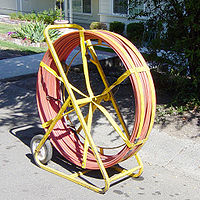 For small diameter pipes there may not be enough room for the tractor mechanism. Instead, a somewhat rigid "fish" is pushed through the pipe and attached to a rope at the access point near the truck. The fish is then pulled to place the rope along the pipe. The rope is then used to pull the inspection pig and cable through the pipe. Detaching the rope, the cable is then used to pull the pig backwards as the pipe is inspected on the monitor (this is the method shown in the illustrations below).
For small diameter pipes there may not be enough room for the tractor mechanism. Instead, a somewhat rigid "fish" is pushed through the pipe and attached to a rope at the access point near the truck. The fish is then pulled to place the rope along the pipe. The rope is then used to pull the inspection pig and cable through the pipe. Detaching the rope, the cable is then used to pull the pig backwards as the pipe is inspected on the monitor (this is the method shown in the illustrations below).
Much of the analysis of what was viewed in the pipeline is conducted at the time of the inspection by the camera operator, but the entire inspection is always recorded and saved for review.
Using software you can easily record digital video and simplify the analysis process, here are some samples of different applications available on the market:
I.T.pipes
Cues Granite xp
WinCan Pipe Inspection Software
Telepresence
Telepresence refers to a set of technologies which allow a person to feel as if they were present, to give the appearance of being present, or to have an effect, via telerobotics, at a place other than their true location....
used to visually inspect the interiors of pipeline
Pipeline transport
Pipeline transport is the transportation of goods through a pipe. Most commonly, liquids and gases are sent, but pneumatic tubes that transport solid capsules using compressed air are also used....
s. A common application is to determine the condition of small diameter sewer
Sanitary sewer
A sanitary sewer is a separate underground carriage system specifically for transporting sewage from houses and commercial buildings to treatment or disposal. Sanitary sewers serving industrial areas also carry industrial wastewater...
lines and household connection pipes.
Older sewer lines of small diameter, typically 6 inches (152.4 mm), are made by the union of a number of short 3 foot (0.9144 m) sections. The pipe segments may be made of cast iron
Cast iron
Cast iron is derived from pig iron, and while it usually refers to gray iron, it also identifies a large group of ferrous alloys which solidify with a eutectic. The color of a fractured surface can be used to identify an alloy. White cast iron is named after its white surface when fractured, due...
, with 12 feet (3.7 m) to 20 feet (6.1 m) sections, but are more often made of vitrified clay pipe
Vitrified clay pipe
Vitrified Clay Pipe is pipe made from clay that has been subjected to vitrification, a process which fuses the clay particles to a very hard, inert, glass-like state...
(VCP), a ceramic material, in 3 foot (0.9144 m), 4 feet (1.2 m) & 6 feet (1.8 m) sections. Each iron or clay segment will have an enlargement (a "bell") on one end to receive the end of the adjacent segment. Root
Root
In vascular plants, the root is the organ of a plant that typically lies below the surface of the soil. This is not always the case, however, since a root can also be aerial or aerating . Furthermore, a stem normally occurring below ground is not exceptional either...
s from trees and vegetation may work into the joins between segments and can be forceful enough to break open a larger opening in terra cotta or corroded cast iron. Eventually a root ball will form that will impede the flow and this may cleaned out by a cutter mechanism and subsequently inhibited by use of a chemical foam - a rooticide.
With modern video equipment the interior of the pipe may be inspected - this is a form of non-destructive testing. A small diameter collector pipe will typically have a cleanout access at the far end and will be several hundred feet long, terminating at a manhole
Manhole
A manhole is an opening used to gain access to sewers or other underground structures, usually for maintenance.Manhole may also refer to:* Manhole , a metal band from Los Angeles* The Manhole, a computer game...
. Additional collector pipes may discharge at this manhole and a pipe (perhaps of larger diameter) will carry the effluent to the next manhole, and so forth to a pump station or treatment plant.
The inspection equipment
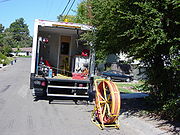 |
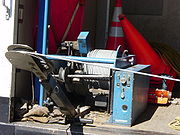 |
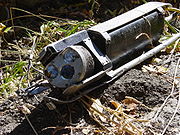 |
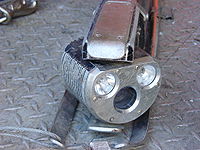 |
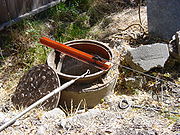 |
The service truck
The service truck contains a power supply in the form of a small generator, a small air-conditioned compartment containing video monitoring and recording equipment, and related computer and display for feature recording.Cable and winch
At the back end of the truck is a powered reel with video cable reinforced with kevlarKevlar
Kevlar is the registered trademark for a para-aramid synthetic fiber, related to other aramids such as Nomex and Technora. Developed at DuPont in 1965, this high strength material was first commercially used in the early 1970s as a replacement for steel in racing tires...
or steel wire braid. Some trucks also contain a powered winch
Winch
A winch is a mechanical device that is used to pull in or let out or otherwise adjust the "tension" of a rope or wire rope . In its simplest form it consists of a spool and attached hand crank. In larger forms, winches stand at the heart of machines as diverse as tow trucks, steam shovels and...
that booms out from the truck allowing for lowering and retrieval of the inspection equipment from the pipeline.
The inspection camera
Sometimes referred to as a PIG (pipeline inspection gauge), the camera and lights are mounted in a swiveling head attached to a cylindrical body. The camera head can pan and tilt remotely. Integrated into the camera head are lighting devices, typically LEDs, for illuminating the pipeline. The camera is connected to display equipment via a long cable wound upon a winchWinch
A winch is a mechanical device that is used to pull in or let out or otherwise adjust the "tension" of a rope or wire rope . In its simplest form it consists of a spool and attached hand crank. In larger forms, winches stand at the heart of machines as diverse as tow trucks, steam shovels and...
. Some companies, such as Rausch Electronics USA, incorporate a series of lasers in the camera to accurately measure the pipe diameter and other data.
Using a camera tractor

The service truck is parked above the access point of the pipe. The camera tractor, with a flexible cable attached to the rear, is then lowered into the pipeline. The tractor is moved forward so that it is barely inside of the pipeline. A "down-hole roller" is set up between the camera tractor and the cable reel in the service truck, preventing cable damage from rubbing the top of the pipeline. The operator then retires to the inside of the truck and begins the inspection, remotely operating the camera tractor from the truck. When the inspection is complete or the camera cable is fully extended, the camera tractor is put in reverse gear and the cable is wound up simultaneously. When the camera tractor is near the original access point, the downhole roller is pulled up and the camera tractor is moved into the access point and pulled up to the service truck. A tractor may be used to inspect a complete blockage or collapse that would prevent using a fish and rope as described below.
Pulling the camera backwards

Analysis of video footage
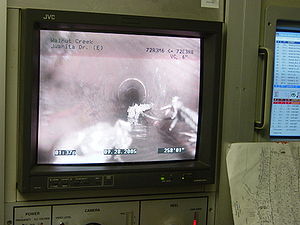 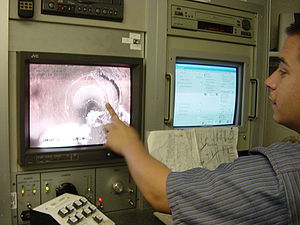 |
Much of the analysis of what was viewed in the pipeline is conducted at the time of the inspection by the camera operator, but the entire inspection is always recorded and saved for review.
Using software you can easily record digital video and simplify the analysis process, here are some samples of different applications available on the market:
I.T.pipes
Cues Granite xp
WinCan Pipe Inspection Software

